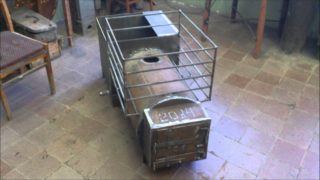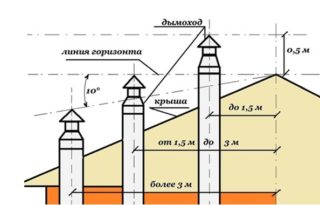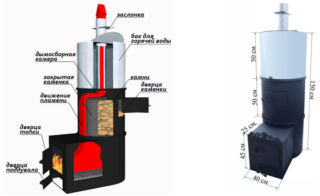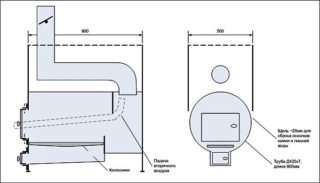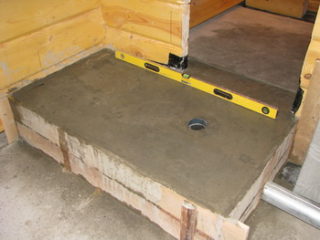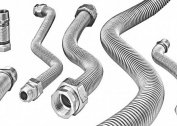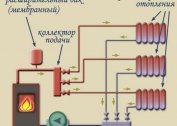Despite the fact that the stove for a bathhouse from the pipe does not look quite aesthetically pleasing, it fully copes with its duties - it quickly and efficiently heats the air in the steam room. This design has an undeniable advantage over other options - the oven can be made independently and fairly quickly, saving time and money. In favor of the stove made of the pipe, its compactness and excellent heat capacity also speaks.
Pros and cons of a homemade design
The materials used for the manufacture of furnaces for steam rooms must have the following qualities:
- heat resistance;
- mechanical strength;
- resistance to corrosion;
- resistance to sharp temperature extremes;
- durability;
- high thermal conductivity and heat capacity.
Ferrous metal is not characterized by high resistance to corrosion, however, the manufacture of a bath furnace from a thick-walled pipe is possible if its diameter is not less than 50-60 cm.
Advantages of this design:
- Ferrous metal is characterized by excellent performance: mechanical strength, high heat transfer and resistance to temperature changes. Moreover, the linear thermal expansion of the material is low.
- The thickness of the pipe is at least 8 mm, which ensures a high heat capacity of the structure, which can retain and gradually give off heat even after the fuel burns out.
- The large thickness of the material extends its service life, despite the fact that the metal is subject to the destructive properties of corrosion.
- The furnace has excellent natural traction, efficient distribution and selection of thermal energy, due to its internal cylindrical shape.
- The number of welds is minimal due to the round shape of the product. Therefore, the likelihood of corrosion, smoke and carbon monoxide leakage is minimized.
- The cost of a used pipe compared to a new one is low. The main thing before buying is to carefully check it for corrosion.
Pipes are different depending on the manufacturing method. The best option would be a hot-rolled seamless pipe or an electric-welded pipe with one longitudinal seam. Products with a screw seam are not suitable, as they are deformed as a result of strong heating.
The main disadvantage of a home-made metal furnace is intense infrared radiation. A person feels it as a strong fever, so close proximity to the stove can cause discomfort. Moreover, the presence of such heat does not mean the same effective heating of the room.
Installation requirements
Before making a furnace from a pipe, it is important to determine the type of design. For this, it is necessary to take into account personal preferences and room parameters - area and layout.
In a small steam room, the optimal option would be a compact design with vertical placement. Such a furnace is equipped with a furnace, heater and a tank for heating water.
The appearance of a vertical stove for a bath from a thick-walled pipe can be compared with a classic stove.
Basic requirements for installing the furnace:
- the distance from the outer surface of the pipe to the walls should be at least 20 cm;
- the design is installed on a previously prepared base;
- at the chimney exit section, a thickening of 12 cm is made;
- a pipe section located in the under-roof space is covered with a lime mortar;
- the ash pan should be located 15 cm from the floor;
- the floor area in front of the ash pan is sewn up with a metal sheet or other heat-resistant material;
- from the outer surface of the roof to the outlet of the pipe, the distance should be at least 50 cm.
Before installation, the furnace is checked for cracks and gaps - the design must be completely tight. Wood cladding in the steam room must be treated with protective compounds. Flammable materials with a plastic, wooden or textile surface are not allowed near the stove in the immediate vicinity.
Self-made methods
When deciding to independently make a stove in a bathhouse from a pipe, it is worth considering that there is no need to talk about a stylish appearance of such a design. However, it fully fulfills its functional purpose, quickly and efficiently heating a steam room with a volume of up to 20 m3.
Structurally, stoves for the bath, made by hand from a steel pipe, are divided into vertical and horizontal. Each variety has its pros and cons. The main criterion for choosing a particular modification should be based on the area and layout of the steam room.
Horizontal location
If it is fundamentally important to maintain free space in the steam room, you should choose a vertical design. But the horizontal furnace has several obvious advantages:
- convenient location of the furnace;
- optimal height of the heater due to the small height of the structure itself;
- excellent heating of stones and a tank of water;
- the light weight of the structure allows you to install it in the center of the room on an ordinary steel sheet, 8 mm thick, provided that the insulation is 20 mm thick;
- uniform distribution of fuel.
The material for the manufacture of horizontal construction may be a pipe with a diameter of 50 cm or an old gas cylinder.
The peculiarity of such a furnace is that it perfectly heats all areas of the steam room, except for the floor.
Vertical layout
The heat transfer level and the burning time of a vertical stove in a bathhouse from a pipe are lower than that of a horizontally mounted structure. This is due to the fact that thermal energy tends to rise, not having time to warm up the metal walls.
The combustion rate of the fuel inside the vertical structure can be reduced by closing the ash pan door and thereby restricting the access of oxygen to the furnace. Another drawback is that in a vertical furnace the fuel burns out immediately as a whole, and in a horizontal - gradually, ensuring uniform heating of the room. The advantage of the vertical design is the more intense heating of the stones and obtaining a more saturated steam.
The efficiency of a horizontal furnace is higher, so it is more advisable to choose such a design. To give the stove an aesthetic appearance, it can be bricked, painted or burnished.
When choosing a composition for painting a metal surface, its heat resistance should be considered. The paint will solve the problem with the appearance of the furnace and protect the metal from corrosion. The heat transfer is influenced by the texture and color of the composition - a matte dark surface gives better thermal energy than a smooth glossy one.
Heated metal emits burning infrared radiation. The masonry will protect it from it, which absorbs heat and will gradually give it to the room.
There are several options:
- using a continuous lining, the furnace can be made aesthetically attractive, but to some extent its heating efficiency will decrease;
- You can increase heat transfer and create more comfortable conditions in the immediate vicinity of the furnace using a small brick heat shield;
- universal options include convector lining with vents.
Processing a metal surface with special chemical compounds is called burnishing. This decoration method provides, in addition to the aesthetic appearance, reliable protection against corrosion.
Features of the drawing
In order to correctly choose the method of placing the furnace in the steam room, it is recommended that you first draw a drawing of the room and the structure itself in order to understand how much space is required to place it.
Structurally, the bath furnace consists of elements sequentially fixed by welding:
- case with blowing, heater, firebox and grates;
- tank for water;
- chimney flue;
- spark arrester in the chimney.
The thickness of steel and the size of the internal section of the product influence the choice of a pipe suitable for a particular design. About the parameters of the product will say the marking "diameter * wall thickness". For a bath furnace, the preferred diameter is 50-60 cm, and the wall thickness is 0.7 - 1.3 cm. Such walls are best processed and during operation do not deform under the influence of high temperatures.
Often for these purposes a pipe with a cross section of 53 cm is purchased - this value is considered the most optimal for a steam room. A small oven with a diameter of 42.6 cm can be installed in a small bath room, for the most part serving as a sink. For a spacious steam room, a pipe with a cross section of 63 cm is suitable.
Choosing the diameter and height of the structure, it is necessary to take into account the area of the steam room and the planned amount of fuel. The larger the furnace, the faster the fuel burns out and more thermal energy is released.
Possible errors in the manufacturing process
If the finished design does not work as we would like, most likely a mistake was made in the process of manufacturing and installing the furnace.
If there is a rapid removal of heat from the furnace, a movable valve must be installed inside the chimney pipe.
A large accumulation of soot inside a horizontal furnace can cause it to ignite. An afterburner in the form of two metal tubes bent to the side of the pipe installed on one of the walls of the structure will help to solve the problem. As a result, the amount of soot will decrease, and the furnace will be better saturated with oxygen, as a result of which the firewood will completely burn out.
Operation tips
Hot metal is dangerous due to serious burns and fire. Therefore, you should follow the simple rules:
- Homemade metal stove is primarily distinguished by its compact size and light weight. But this should not affect the refusal to manufacture an individual foundation for the design. The height of the base must be at least 20 cm from the floor surface. The foundation material may be monolithic reinforced concrete, solid blocks of concrete, or brickwork.
- The floor in front of the furnace with a blower is covered with a metal sheet measuring 50 x 70 cm.
- Opening doors should be directed towards the entrance opening of the steam room or dressing room.
- There should be a free distance of at least 100 cm between the chimney and other hot metal structural elements and the wooden walls of the room.
- The tank should be filled with water before starting the kindling of the bath. In order to avoid steam shock and thermal injury, it is not allowed to fill the tank with water while the furnace is running.
- Condensation with an aggressive chemical composition forms on the inner wall of the chimney. To reduce its quantity, the chimney pipe is insulated from the outside with mineral or basalt wool. The thickness of the insulation should be at least 8 - 12 cm. On sale you can find ready-made chimneys in the form of a stainless steel sandwich pipe.
The independent manufacture of a furnace for a bath attracts with a low cost of the product and the opportunity to take into account its own preferences, as well as the parameters of a single room.A metal furnace can help out at the stage of construction and modernization of a bath with a capital brick stove or during the construction of a temporary washing.
